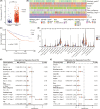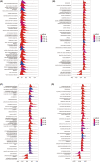Computed tomography-based radiomics prediction of CTLA4 expression and prognosis in clear cell renal cell carcinoma
- PMID: 36397666
- PMCID: PMC10067074
- DOI: 10.1002/cam4.5449
Computed tomography-based radiomics prediction of CTLA4 expression and prognosis in clear cell renal cell carcinoma
Abstract
Objectives: To predict CTLA4 expression levels and prognosis of clear cell renal cell carcinoma (ccRCC) by constructing a computed tomography-based radiomics model and establishing a nomogram using clinicopathologic factors.
Methods: The clinicopathologic parameters and genomic data were extracted from 493 ccRCC cases of the Cancer Genome Atlas (TCGA)-KIRC database. Univariate and multivariate Cox regression and Kaplan-Meier analysis were performed for prognosis analysis. Cibersortx was applied to evaluate the immune cell composition. Radiomic features were extracted from the TCGA/the Cancer Imaging Archive (TCIA) (n = 102) datasets. The support vector machine (SVM) was employed to establish the radiomics signature for predicting CTLA4 expression. Receiver operating characteristic curve (ROC), decision curve analysis (DCA), and precision-recall curve were utilized to assess the predictive performance of the radiomics signature. Correlations between radiomics score (RS) and selected features were also evaluated. An RS-based nomogram was constructed to predict prognosis.
Results: CTLA4 was significantly overexpressed in ccRCC tissues and was related to lower overall survival. A higher CTLA4 expression was independently linked to the poor prognosis (HR = 1.458, 95% CI 1.13-1.881, p = 0.004). The radiomics model for the prediction of CTLA4 expression levels (AUC = 0.769 in the training set, AUC = 0.724 in the validation set) was established using seven radiomic features. A significant elevation in infiltrating M2 macrophages was observed in the RS high group (p < 0.001). The predictive efficiencies of the RS-based nomogram measured by AUC were 0.826 at 12 months, 0.805 at 36 months, and 0.76 at 60 months.
Conclusions: CTLA4 mRNA expression status in ccRCC could be predicted noninvasively using a radiomics model based on nephrographic phase contrast-enhanced CT images. The nomogram established by combining RS and clinicopathologic factors could predict overall survival for ccRCC patients. Our findings may help stratify prognosis of ccRCC patients and identify those who may respond best to ICI-based treatments.
Keywords: CTLA4; biomarker; clear cell renal cell carcinoma; machine learning; radiomics signature.
© 2022 The Authors. Cancer Medicine published by John Wiley & Sons Ltd.
Conflict of interest statement
The authors declare that the research was conducted in the absence of any commercial or financial relationships that could be construed as a potential conflict of interest.
Figures





Similar articles
-
Development and validation of a CT-based nomogram for preoperative prediction of clear cell renal cell carcinoma grades.Eur Radiol. 2021 Aug;31(8):6078-6086. doi: 10.1007/s00330-020-07667-y. Epub 2021 Jan 29. Eur Radiol. 2021. PMID: 33515086
-
Radiomics nomogram based on CT radiomics features and clinical factors for prediction of Ki-67 expression and prognosis in clear cell renal cell carcinoma: a two-center study.Cancer Imaging. 2024 Aug 6;24(1):103. doi: 10.1186/s40644-024-00744-1. Cancer Imaging. 2024. PMID: 39107799 Free PMC article.
-
Integrative radiogenomics analysis for predicting molecular features and survival in clear cell renal cell carcinoma.Aging (Albany NY). 2021 Mar 26;13(7):9960-9975. doi: 10.18632/aging.202752. Epub 2021 Mar 26. Aging (Albany NY). 2021. PMID: 33795526 Free PMC article.
-
Radiomic Prediction of CCND1 Expression Levels and Prognosis in Low-grade Glioma Based on Magnetic Resonance Imaging.Acad Radiol. 2024 Nov;31(11):4595-4610. doi: 10.1016/j.acra.2024.03.031. Epub 2024 Jun 1. Acad Radiol. 2024. PMID: 38824087 Review.
-
CT-based radiomics for differentiating renal tumours: a systematic review.Abdom Radiol (NY). 2021 May;46(5):2052-2063. doi: 10.1007/s00261-020-02832-9. Epub 2020 Nov 2. Abdom Radiol (NY). 2021. PMID: 33136182
Cited by
-
Predicting treatment response to systemic therapy in advanced gallbladder cancer using multiphase enhanced CT images.Eur Radiol. 2025 May 8. doi: 10.1007/s00330-025-11645-7. Online ahead of print. Eur Radiol. 2025. PMID: 40341972
-
Machine Learning-Based Pathomics Model to Predict the Prognosis in Clear Cell Renal Cell Carcinoma.Technol Cancer Res Treat. 2024 Jan-Dec;23:15330338241307686. doi: 10.1177/15330338241307686. Technol Cancer Res Treat. 2024. PMID: 39703069 Free PMC article.
-
ConvXGB: A novel deep learning model to predict recurrence risk of early-stage cervical cancer following surgery using multiparametric MRI images.Transl Oncol. 2025 Feb;52:102281. doi: 10.1016/j.tranon.2025.102281. Epub 2025 Jan 11. Transl Oncol. 2025. PMID: 39799749 Free PMC article.
-
Computed tomography-based radiomics predicts prognostic and treatment-related levels of immune infiltration in the immune microenvironment of clear cell renal cell carcinoma.BMC Med Imaging. 2025 Jul 1;25(1):213. doi: 10.1186/s12880-025-01749-3. BMC Med Imaging. 2025. PMID: 40596969 Free PMC article.
-
Radiomics predicts the prognosis of patients with clear cell renal cell carcinoma by reflecting the tumor heterogeneity and microenvironment.Cancer Imaging. 2024 Sep 16;24(1):124. doi: 10.1186/s40644-024-00768-7. Cancer Imaging. 2024. PMID: 39285496 Free PMC article.
References
-
- Powles T, Plimack ER, Soulieres D, et al. Pembrolizumab plus axitinib versus sunitinib monotherapy as first‐line treatment of advanced renal cell carcinoma (KEYNOTE‐426): extended follow‐up from a randomised, open‐label, phase 3 trial. Lancet Oncol. 2020;21(12):1563‐1573. - PubMed
Publication types
MeSH terms
Substances
LinkOut - more resources
Full Text Sources
Medical

